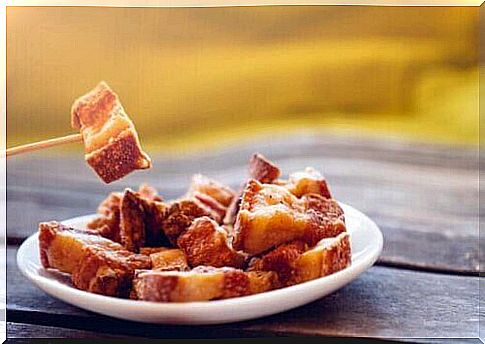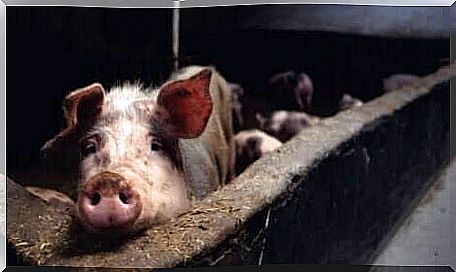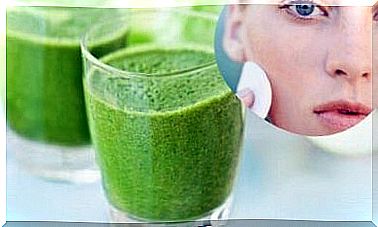Can Eating Pork Rind Be Risky For The Body?
Pork rind contains high biological value fats and proteins, but it is often eaten fried, which increases the percentage of trans fat in the final product.

Pork rind is a food that is consumed frequently in many villages. While it is true that its consumption is not usual in cities, it is a product that has an interesting nutritional value. It is also common to find it in oriental markets, where it is considered a great delicacy.
One thing is clear: almost anything can be eaten in pork. Depending on the culture, the consumption of certain parts or others is more common, but even the viscera can be eaten by humans. However, it should be noted that all the elements of this animal do not enjoy the same quality.
How is pork rind prepared?
Pork rinds are usually eaten fried. The most usual is to prepare it in a pan with butter and let it brown until a crispy crust forms. For many, it is a real delicacy.
Once the rind is prepared, it can be served as a sole dish or to accompany other types of preparations. It is also eaten as a starter and can even be eaten at any time as a snack. Nevertheless, its energy density is high.
Nutritional values
As we said, due to the cooking method to which the pork rind is subjected, this food stands out for its caloric intake. For every 100 grams of product, 544 kilocalories are consumed.
You have to be careful with this aspect because an imbalance in energy intake generates weight gain, which negatively affects general health.
From a macronutrient perspective, pork rind already consists of a high concentration of fat, with 31 grams for every 100 grams of food. In addition, the protein intake is also important, with 61 grams of high biological value.
Regarding micronutrients, it is necessary to highlight the content of vitamins A and B in pork rind, as well as its concentration of calcium, magnesium and iron.

Possible health benefits of pork rind
We are now going to talk about the possible health benefits that derive from pork rind, as well as the scientific opinion on this subject.
Less risk of developing anemia
Anemia is a pathology which can be conditioned by a lack of iron, thus generating a situation of chronic fatigue, motivated by an ineffective supply of oxygen at the cellular level.
Regular consumption of this mineral helps reduce the risk of developing this pathology, as stated in a study published in The Medicals Clinics of North America .
Better muscle health
The proteins provided by the pork rind have a high biological value and obtain good marks for their digestibility. These two conditions guarantee their quality: they are therefore useful for safeguarding the good health of muscles and lean mass.
Thus, ingesting pork rind can help develop hypertrophy processes or repair muscles.
Possible risks
The greatest risk of the presence of pork rind in the diet is linked to the way it is cooked. While the ingestion of saturated fat and dietary cholesterol may not pose a significant health problem, trans-type lipids are not.
It must be taken into account that it is almost always eaten fried, which causes a change in the spatial arrangement of fats, from cis to trans. According to a study published in the journal Diabete & Metabolic Syndrome , regular ingestion of these nutrients is associated with a greater risk of developing chronic pathologies, due to the ability of these fatty acids to increase inflammatory processes.
Popularity in the keto diet
It is true that pork rind is a food commonly found in many types of ketogenic diets. This is due to its high nutritional density.
It is able to provide proteins of high biological value in large quantities, as well as monounsaturated lipids and essential micronutrients.
Its configuration makes it a product that easily generates satiety, so it can help increase adherence to different types of food. Nevertheless, its consumption is not without risks, especially in the medium term and linked to its cooking method.
How do you recommend eating pork rind?
If deep-frying pork rind is not recommended, there are other alternative cooking methods that are safer. We are talking, for example, of cooking with water.
It is true that this way, we will not see the crispy and more fatty crust appear, but it is a much more suitable method for the organism. It is also possible to find certain recipes which cook this product stewed or cook it at low temperature, thus obtaining a dish of greater quality.
Pork rind: a food with a high nutritional density
As you have seen, pork rind is a food that is consumed very frequently in certain populations, even if its presence in the diet of inhabitants of western cities is not usual. It is a product with a high nutritional density, which provides high biological value proteins and fats.
Anyway, to get the greatest benefit in terms of health, it is better to opt for a less aggressive cooking method, different from frying. We will thus benefit from a final dish with a lower percentage of trans-type fatty acids.









